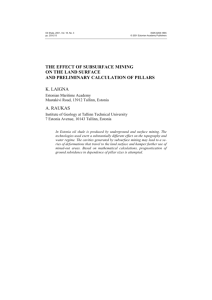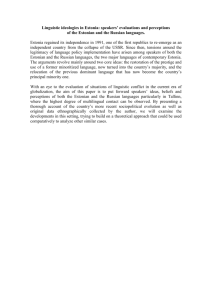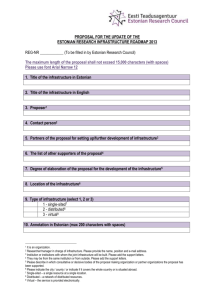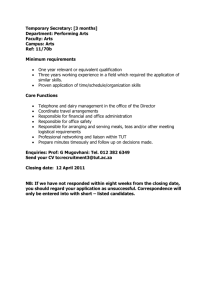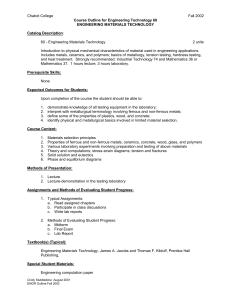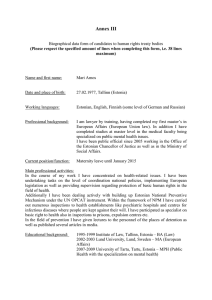Materials technology in Estonia: Demand and supply
advertisement
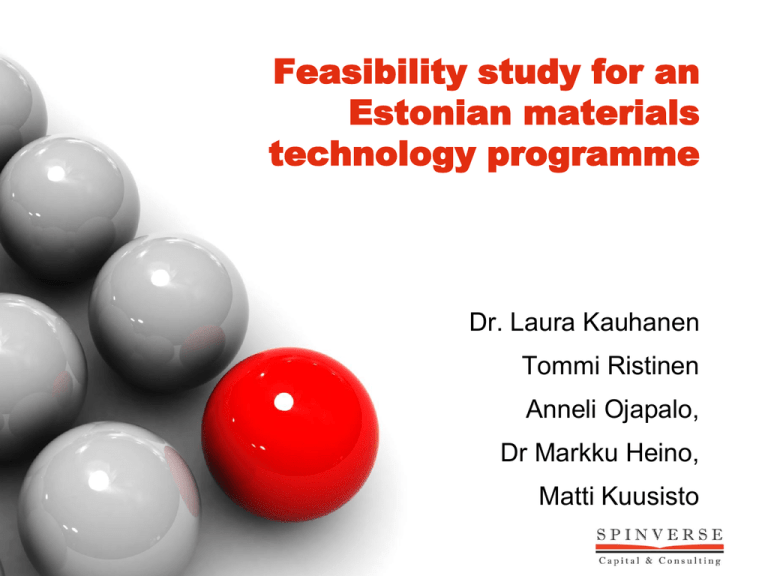
Feasibility study for an Estonian materials technology programme Dr. Laura Kauhanen Tommi Ristinen Anneli Ojapalo, Dr Markku Heino, Matti Kuusisto Spinverse works with the Nano- and Materials Technology Innovations Internationally Finnish national Technology Programme Coordination: -Nanotechnology (70M€) -Functional Materials (205M€) -Fuel Cells (140M€) - Etc. Nanotech Northern Europe 2005, 2006, 2007 Helsinki, FInland Nano- and materials tech Business Consulting - Technology transfer -Markets -- Business development - Strategy -Capital raising Nanotech Northern Europe 2008 Copenhagen, Denmark Nanotechnology cooperation agreement between Finland and China Nanotech Europe 2009 Berlin, Germany Nanotechnology cooperation agreement between Finland and Russia ObservatoryNano –project under European Commission Estonian national materials technology programme feasibility study EuroNanoForum 2011 Nanotech Europe 2011 Budapest, Hungary What do we mean when we talk about innovation? Let’s enlighten the topic with a historical example… Innovation begins with a discovery In 1600, William Gilbert coins the term electricity (‘like amber’) The discovery gives rise to an invention In 1600, William Gilbert coins the term electricity (‘like amber’) 1879: Thomas Edison demonstrates the incandescent light bulb The invention is commercialised In 1600, William Gilbert coins the term electricity (‘like amber’) 1879: Thomas Edison demonstrates the incandescent light bulb 1890: His businesses combine to become Edison General Electric What does Spinverse do? Some background: Materials are at the core of industrial innovation and enable it. /European Comission Spinverse confidential Background • The European Comission has recently addressed the relevance of materials science and engineering for the European well-being and industrial competiveness. • Added value materials with higher knowledge content, new functionalities and improved performance are critical for industrial competiveness and sustainable development • The materials themselves represent a key step in increasing the value of products and their performance Materials technology is in challenging competitive position in the whole Europe – it is a perfect time for Estonia to answer these challenges • • • Materials technology eroding in Europe USA and Japan traditional leaders South-America, China, India and Eastern-Europe strongly emerging Human resources are an issue Materials technology is very research intensive Co-operation between industry and academia is extremely important Co-operation and concurrent engineering needed Materials technology allows breakthroughs in other technological areas Catalyst for innovation Required close co-operation between e.g. machine building, process technology and chemical technology => High requirement for knowledge management and clever design practices Source: EuMaT Roadmap Materials technology is by nature an enabling and interdisciplinary field of technology • It provides significant added value on different fields of industry enabling renewal and increased productivity of existing industrial fields as well as development of new business areas based on high added value products and services. Estonian Materials Technology Feasibility study Aim of the study is to analyse Estonian industry and R&D competence in short, medium and long term • Analyse technology trends in materials technology and advanced materials in medium and long term perspective. • Provide an analysis of short-to-medium term technology transfer and an overview of promising business fields for the Estonian industry and service sector in medium and long term perspective. • Evaluate the Estonian materials science and technology research areas from mid-to-long term commercialisation perspective. Timeline for the study: What has been done (October-March) • • • Preliminary research Desk research, patent analysis, project analysis and publication analysis 5 preliminary interviews Main study Desk research and analysis continued Questionnaire to university research group leaders in materials technology and similar Over 30 interviews in industry and academia Intermediate report in December Reporting and dissemination Workshop for preliminary dissemination, validation and discussion in March 2011. Report was sent to 202 emails for review. Responses were got from 15 persons. Final report Dissemination Based on publications, patents and questionnaire Strong areas of Estonian materials technology • • Advanced materials Photovoltaic materials Nanomaterials Carbon based nanomaterials Electroactive polymers and electrically conductive polymers Rare-earth metals Advanced sensor materials Metal-matrix composites Energy technologies Thin film solar cell technology Supercapacitors Fuel cells • • • • Micro and nanoelectronics E-paper Atomic Layer Deposition Coatings technologies Advanced coatings for metals industry Electro-optical coatings Biotechnology and biomaterials (e.g. biopolymers) Measurement, modelling and processing technologies Computational chemistry Measurement technology in general Laser technology Atomic Force Microscopy Materials technology in Estonia: Demand and supply Could the industry use materials technology for renewal and an upgrade? Industry Employment Sales Metals and machinery 25 000 1900 MEUR Forest industry 30 000 1200 MEUR Chemical industry 2 800 300-500 MEUR Plastics industry 3 500 300 MEUR Construction materials 5 000 700 MEUR Textiles industry 15 000 350 MEUR There is globally a huge potential for advanced materials for metals and machinery – Estonian research matches well with these needs • Metal coatings and surfaces Tribological coatings Wear reduction (~7% of GNP in developed countries) • Composites for replacing metals in various applications Cermets (TiC, Cr2C3) Use of other advanced materials to replace metals • Modelling and measurement Non-destructive evaluation and testing Atomic Force Microscopy, Surface Probe Microscopy, other measurements Conclusions • In conclusion, there is very high potential in the Estonian metals and machinery sector Large company base, high net sales and high export rates Some companies with good potential to adopt novel materials technologies due to their large size (e.g. BLRT and Norma) Long traditions in specific fields such as toolmaking, which requires high quality coatings • Key challenges for Estonia Need to build more complete value chains including large companies, smaller subcontractors and universities Need to decrease the gap between universities and companies – this is an important challenge also globally • Important companies Norma, BLRT The large forest industry is mostly related to mechanical processing of wood • Industry overview 30000 employees, 1200 MEUR sales/year 14% of total exports, positive trade balance Important subsectors in: Sawmilling Joinery and prefabricated buildings Log-houses Furniture Construction supplies • R&D work Very small group in Tallinn University of Technology studying chemical treatment Development related to mechanical production conducted in Võrumaa Kutsehariduskeskus and in Maaülikool Forest industry is undoubtedly very important for the Estonian economy – R&D base is rather low, though • Despite the high importance of the industry, there is practically no advanced materials research in Estonia regarding wood based materials • There is only one small research group conducting wood chemistry (in TUT), which mostly does applied research according to company needs • Developing high quality research in advaced wood based materials requires a lot of time and effort • Large majority of the teaching and development is related to mechanical processing Does Estonia want to invest in this or is wood chemistry research required at all? Important companies Estonian Cell, Stora Enso, UPM Chemical industry is an important raw materials producer for other industries • Industry overview 3000 employees, 300 – 500 MEUR sales/year Important subsectors for materials technologies Oil shale production Rare earth metals production Construction chemicals • R&D work Very strong R&D base in universities in fundamental research: TUT, TU, KBFI, ... Also in modelling and measurement (e.g. research that lead into establisment of Molcode) Key implications for the plastics industry • There is a clear need for higher added value products in the Estonian plastic industry This calls for more collaboration between/within companies and universities Current subcontracting business models are making collaboration difficult • Plastics are extremelly important materials for future Polymer composites for transportation, construction and machinery Plastic and printed electronics (lighting, packaging, solar cells, ...) Packaging • Interesting companies Estiko Plastar, Nordbiochem Construction materials is the most varied sector of all compared • The share of advanced materials technologies is still very low globally (~1% of products have nanoenhanced features) Price pressure is very high for construction materials • There are very interesting initiatives related to advanced materials related to construction materials • ENCC, Andrese Klaas, Clay Processing Services R&D work Very dependent of the raw material and application (minerals, oil shale, textiles, wood, chemicals) Dedicated research done mostly in TUT. Chemistry and physics also in TU, KBFI and ENCC. Textiles industry needs to start looking for higher value added products • Industry overview 15 000 employees, sales 350MEUR/year Mostly related to production of clothing and home textiles • R&D work Mostly conducted in TUT, some physics research is also related (TU, ENCC) • Textile industry needs more competitive products Technical textiles offer huge benefits for many industries (medical, construction, etc, etc.) (similar to plastics in a way) • Interesting companies Esfil Tehno, Haine Paelavabrik, Toom Tekstiil, ENCC In addition there a growing high-tech industry based on materials technology We identified several Interesting start-up companies • • • • • • • Skeleton Technologies Crystalsol Nordbiochem Micromasch Fits-me Baltic Technologies Development Elcogen What about Technology transfer? Research groups working on different materials and developing technology to different industries Estimate of overall situation Coatings SemiCeramics, and surface Optical NanoTotal Metals conductors concrete Polymers treatment materials materials Total 19 13 11 17 20 13 21 Electronics / ICT 14 7 9 9 9 9 Forest and paper 5 Metal 8 8 Construction 10 6 Machinery 11 9 7 Energy 22 8 10 6 9 6 11 Environment 15 6 6 7 9 Chemical industry 13 9 7 Biotechnology 12 7 Education For transfer technology there has to be educated people to apply the new technology in a company • Not enough educated people in companies • To bridge the gap between education and especially the traditional industry co-operation is extremely important. • In all but two of the interviewed cases most of the PhDs were employed by the Universities, this was especially true with the more traditional fields of materials science such as metals and machinery. • Some small efforts are underway to tackle these problems: Joint PhDs, Master’s programs with industry (ENCC) etc. Materials technology abroad: co-operation and competition International collaboration is Research not R&D focused • University groups in Estonia are very well connected internationally. • Many companies have international connections through their clients or owners. • Companies are less connected to international research institutes or other companies doing R&D. Programs enhance collaboration but there is still low collaboration between Nordics and Baltics • Most of the neighbouring countries of Estonia are focusing their materials technology efforts on similar technology areas as Estonia. • All neighboring countries have established Materials technology R&D programmes during the last ten years. Also several nanotechnology programmes have been established. • The outcomes and results of these programs are still somewhat unclear, mostly because they are so difficult to measure. Benefits: increased cooperation between academia and industry increased international cooperation: but cooperation has mostly been facilitated beyond the boards of Europe. Nordics and Baltics are not collaborating with each other Conclusions and Recomendation Conclusions and Recommendations based on Technology Readiness Level • • • • Mature technologies and well established companies Technologies close to market entry Applied research Fundamental research Key role of ”mature” manufacturing industry • Largest economic potential with lowest risks Motivate companies to create and produce higher added value products! More educated workforce is needed to understand new technology and advanced materials Interest in high technology and advanced materials need to be awaken in companies =>Applying materials knowledge is key to success in all areas • Not everything needs to be invented in Estonia • Support clever technology scouting from abroad Technologies and companies close to market entry are very important to the success of Estonian materials technology in the short term • These companies have highest potential in the medium term Not interesting from technology transfer point of view Most (all) efforts are focused in commercialising the main product • The companies need good support from private investors, public sector as well as highly determined and skilled team With good support, there is potential to grow new success stories in 3-5 years of time • But, the size of investments needed is usually very much higher than for e.g. ICT (initial investment for starting up production in scale of 1-2 MEUR or more) International investments need to be attracted to Estonia, too Remember: Quick wins should not be expected from new materials development – application oriented solutions are quicker to implement Applied research is not transfered enough • Technologies in the applied research phase typically have the highest potential for technology transfer • There is currently a clear mismatch between materials technology inventions in Estonia and requirements and capabilities of the industry • • • Highest potential for technology transfer exist in the metals industry coatings segment (strong industry + many research groups) There are also other interesting initiatives for technology transfer in Estonia in various advanced materials Universities are currently key player in applied research – their role needs to be clarified and simplified to get more companies interested in collaboration Universities should be more attractive partners to private companies, there is much more value to the economy with a technology being commercialised by an Estonian company than with a single patent sold abroad Funding for research needs to be reorganised / reconsidered • This was heard from both researchers and companies The role of Fundamental research is important in creating knowledge and skills to be able to adapt to future changes • • There are internationally strong areas of research in Estonia in some areas of fundamental physics, chemistry and materials The huge number of different areas of research mean that it is very difficult to create world class technology on several areas A small country should carefully think of focus areas where it is putting its efforts in order to provide industrially applicable findings, either for local industry or for international technology transfer The country should define a national strategy and roadmap for future focus areas in materials technology based on strong areas of research and potential synergies in the university research (coatings technology is a good example) Moreover, universities and even research groups should have a concrete strategy on where to develop their expertise Approaches for the future efforts on materials technology in Estonia 1. Industry driven small R&D programme on materials technology with 5-10 key players. 2. Applied research Materials Technology programme (where each project has to have industrial partners) 3. Programme to distribute all funding given to fundamental research and applied research funding in Materials technology development 4. Supporting actions but no Program to distribute funding 5. Programme with strong support actions to prepare for future funding “Materials R&D to business” “Materials R&D to business” - Programme • • Programme has two phases. First phase lasts 2-3 years where there is strong emphasis on Programme support actions Facilitation concentrates on Dissemination of current materials technology research to traditional industry Enhancement of industry-university cooperation. Help in applying for funding of joint applied research projects (both national and international funds) Activation of industry to do R&D Activating Materials technology industry-education projects In dedicated areas (as chosen in this report), together with industry associations technology-industry road-maps should be done and valuechains could be explored An important part of facilitation should be on international activity “Materials R&D to business” - Programme • • • • After the first phase there will be a midterm evaluation to assess the continuation of the program. In the second phase the programme could include own funding focused on getting materials technology to business. However, the distribution of this funding should be made as simple as possible. For best benefit the programme should be started soon after this feasibility study has ended. The key success factor is related to the programme coordinator/facilitator. This person has to Understand the technology, technology transfer, and industry needs Know the situation in Estonia Be up-to-date with world-wide developments and trends Work in cooperation with other iniatives (industry associations, clusters, other programs, international programs etc.) As a final remark. Researchers: Companies Government Pingutage uuenduste nimel WHY ESTONIA? WHAT MAKES A SMALL NATION KNOWN Whatever it is our advise to you: OUT-OF-THE-BOX THINKING? CREATIVITY? Pingutage Uuenduste Nimel! INNOVATION? Materials technology can renew your industry Snapshot of Estonian research Spearheads of Estonian R&D Semiconductors Nanomaterials Oil shale •Condensed matter physics + semiconductor physics •Inorganic chemistry •Nanoelectronics •Nanoelectronics •CNTs, graphene •Carbides •Thin films and coatings •Oil shale for energy •Oil shale for chemicals •Oil shale waste utilisation •UT, TUT, ENCC •UT, TUT, ENCC •TUT, ENCC •TUT, TKTK, UT •TUT, UT •TUT, UT, EBC, TFTAK, KBFI •Tribological coatings •Metals replacement by hybrids, composites •Electroactive polymers •Electrically conductive polymers •Various areas of biotechnology •Little materials relevance Metals Polymers Biotechnology Solar cell research is mostly based in Tallinn University of Technology Semiconductors Nanomaterials Solar cell technologies Semiconductor materials Electrically conductive polymers Hybrid organic-inorganic materials Thin films, coatings and deposition Nanomaterials TUT Crystalsol Polymers Biotechnology Many researchers are studying subjects and materials relevant for sensor technologies Semiconductors Nanomaterials Sensor technology Semiconductor materials Electrically conductive polymers Thin films, coatings and deposition Nanomaterials Laser technology Biosensors Rare-earth metals and oxides TU ENCC TUT Evikon MCI ... Polymers Biotechnology Energy storage materials research is mostly based in Tartu Nanomaterials Energy storage materials and technologies Fuel cells and materials Supercapacitors and materials Electrochemistry Nanomaterials Carbon based materials TU KBFI Elcogen Skeleton Technologies Metals Polymers There is large industry and research base for advanced materials in metals industry Nanomaterials Novel coatings, composites and hybrids for metals industry Wear reduction Tribological coatings Novel composites and hybrid materials Metals TUT TKTK TU Metals and machinery Polymers Toolmaking There is a lot of expertise and state-of-the-art equipment related to materials technology ”support functions” Semiconductors Nanomaterials Oil shale Measurement, modelling and computation •Computational chemistry •Measurement technology •Laser technology •State-of-the-art equipment •UT, TUT, ENCC, KBFI, ... •MikroMasch, LDI, other laser companies, Molcode, Baltic Technology development Metals Polymers Biotechnology Biotechnology and oil shale technologies are also very much studied Oil shale Research mostly related to energy applications •Oil shale for energy •Oil shale for chemicals •Oil shale waste utilisation •TUT, ENCC There is little materials relevance in biotechnology research •TUT, UT, EBC, TFTAK, KBFI •Various areas of biotechnology •Little materials relevance Biotechnology High materials relevance Solar cells and materials Sensor technologies Novel coatings and materials for metals industry Energy storage materials Measurement, modelling and computation Low materials relevance Oil shale Biotechnology
